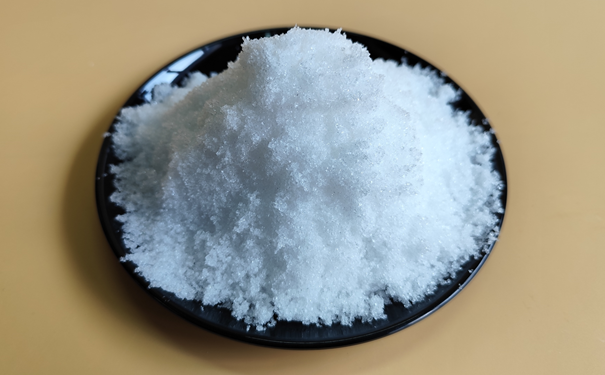The main function of potassium phosphite is to supplement phosphorus, potassium, sterilization, disease resistance, anti-reversal, and potassium dihydrogen phosphate appearance is similar, but its molecular structure type, mechanism of action, composition is completely different, its advantage is better than the bactericidal effect of ordinary phosphate and potassium fertilizers, the disadvantage is that the price is more expensive than the ordinary nitrogen, phosphorus and potassium fertilizers. There are more specifications of potassium phosphite, the liquid is generally 0-520-340/0-525-375g/L, and the solid can be labeled according to the percentage (P58%, K2O38%). The PH value of potassium phosphite can be adjusted to 3-5,5-7,7-9 and other ranges according to the requirements of different indexes. Liquid potassium phosphite can be compounded with nitrogen, phosphorus, potassium, magnesium, boron, copper, zinc, iron and other trace elements, such as compounding with calcium, it is necessary to add ion-retaining agent to prevent precipitation precipitation.

Product index
Model A index:
Potassium phosphite ≥98%
P2O5 ≥44%
K2O ≥58%
Cl ≤0.1%
Fe ≤0.005%
Water-insoluble matter ≤0.5%
PH:7.0-9.0
Model B index:
Potassium phosphite ≥98%
P2O5 ≥58%
K2O ≥38%
Cl ≤0.01%
Water insoluble matter ≤0.3%
Fe≤50mg/kg
PH: 3.0-5.0
Model C index:
P2O5≥520g/L
K2O≥340g/L
Cl≤0.01%
Water insoluble matter ≤0.3%
PH: 4.0-5.0
Model D index:
Potassium phosphite ≥50%
P2O5≥22%
K2O ≥29%
Cl≤0.1%
Fe≤0.005%
Water insoluble matter≤0.5%
PH: 7.0-9.0
Product characteristics
1, with excellent bactericidal and disease-resistant effect
The +3-valent phosphorus content of potassium phosphite is very high, with good water solubility, which can guide the production of biostimulants, PA phytochemicals and so on after absorbed by the crops to enhance the active defense mechanism, and has a wide range of bactericidal effect on the diseases such as Lucid fungus disease, Lucid blight, rotting mildew and so on.
2, good compatibility
can be compounded with a variety of nitrogen, phosphorus, potassium and trace element fertilizers, especially with boron, molybdenum, copper, zinc and other elements, its synergistic effect is more obvious. According to a certain formula after the compounding of copper phosphite in the potato yield, antibacterial effect is very obvious.
3, green environmental protection
Potassium phosphite after use, in the air, soil, water, sunlight will be gradually oxidized into potassium phosphate fertilizer, almost 0 pollution 0 residual green fertilizer. At the same time, it will not cause the phenomenon of soil nodulation, acidification, salinization and so on.
4, the use of a wide range of
can be applied to different temperatures, humidity, climatic conditions, on potatoes, citrus, rice, grapes, lilies, orchids, orchids, tiger orchids, orchids, mandarin orange, papaya, avocado seedlings, lychee, chili peppers, bell peppers, tomatoes, lettuce, and other crops have different effects.
The mechanism of action
After absorbing potassium phosphite, its phosphite ions can quickly start the active defense mechanism of the crop, guiding the crop to produce phytochemicals and lignin in large quantities, increasing the thickness of the cell wall, and initiating the full-featured anti-disease mechanism. Trivalent phosphorus in the crop body can occur a series of complex electrochemical, redox reaction, change the local charge, trigger the cell to start the active defense system. In this process the crop's gene expression, soluble protein content, and oxidative enzyme activity reach a high state. From time to time, the use of potassium phosphite can regulate the growth, stomatal opening and closing, control the tip of the crop, promote the flowering, and the greening of young fruits.
The use of
1, alone can be diluted 600-1500 times spraying.
2, Drip irrigation can be in accordance with 2-5 kg/mu.
3, can be used with nitrogen, phosphorus, potassium, boron, zinc, copper and other trace elements compound, can also be used with some pesticides, need to be verified before use to react. To avoid precipitation or flocculation.
V. Examples of some formulations
1, Prevention of citrus yellow dragon disease formulations
Potassium phosphite 75.0%, ammonium phosphite 5.0%, urea 12.0%, EDTA magnesium 4.0%, boron fertilizer 1.9%, EDTA zinc 1.0%, potassium indole butyric acid 0.1% or sodium compound nitrophenol 0.1%, co-solvent 1%
2, general-purpose formulas
Potassium phosphite 60%, 40% of the water, can be prepared 0-520-340 Liquid water-soluble fertilizer.
Precautions
1, avoid mixing with potassium permanganate, sodium percarbonate, calcium peroxide, strong alkali, strong acid and so on.
2, Cannot be used with calcium chloride, calcium sulfate, calcium carbonate and some organic calcium.
3, Solid potassium phosphite is easy to absorb moisture, after opening, it must be sealed and stored in time.
The solubility of solid potassium phosphite is very high, up to 150g/100ml water, the specific gravity of liquid is generally up to 1.4g/ml, its role is still in the continuous research and discovery, the safety has been verified after many years of use of its safety and reliability. Potassium phosphite can be compounded and mixed with vitamins, alginate, humic acid, boron, zinc, magnesium, nitrogen and other fertilizers, but it will react and precipitate with inorganic calcium, so it is necessary to add ionic retention agent.
Tel:+86-512-36622455
Fax:+86-512-36874501
Phone:+86-13358057724
Email:hxo@hxochem.com
Add:No. 1377, Fuchunjiang Road, Kunshan Development Zone, Suzhou, Jiangsu, China